-

人教版新目标初中英语八年级下册Have you ever been to an amusement park教案
(1)Have you ever been to …? Yes, I have. / Yes, I have ever been to …No, I haven’t. / No, I have never been to …(2)When did you go there? I went there last year. (3)I have never been to a water park. Neither have I. I have ever been to an amusement park. So have I. (4)How long have you been studying English? I’ve been studying English since nine o’clock. I’ve been studying English since I came back home. I’ve been studying English for five hours. (5)What’s that? It’s an amusement park in Japan. I’ve never been to an amusement park like it before. It’s fun to learn another language. Let’s go tonight. Isn’t this great?space museum, amusement park, water park, South America, Peru, Holland, European culture, tour guide, flight attendant, musical instrument, more than, be from, get to, take lessons, neither, discover, graduate, change

人教版新目标初中英语八年级下册What should I do教案2篇
说明:在帮Li Lei提建议的同时,教育学生如何学好英语。第三课时教学目标1. 语言目标:a) 词汇: Original, in style, haircut, the same as.b) 语言结构:My friend wears the same clothes and has the same haircut as I do.2. 能力目标:大多数学生能够谈论自己喜欢哪种服装,提高查找信息的能力。3. 情感目标:学会如何与朋友相处,要有自己对时尚的看法。教学重点掌握一些重要词汇。教学难点学会谈论问题,并能提出书面建议。◆教学突破首先针对Erin的问题,提出个人的建议,模仿2c部分的对话展开双人交际Pair-work;听老师诵读3a部分的信件,并找出LEFT OUT的问题所在;学生完成3b部分的内容,给Left Out提出书面的建议;学以口头形式提出自己目前存在的某个问题,讲给大家听,让同学们给自己提出一个建议,并作笔录;学生两、三个人分成一组,随意性地进行口语交际,谈论P14的第4部分的某个问题,相互交换意见。

人教版新目标初中英语八年级下册If you go to the party, you’ll have a great time教案2篇
区分宾语从句、定于从句和状语从句宾语从句和状语从句,都叫做主从复合句。宾语从句主要是中考必考的,是初中阶段必掌握的从句,宾语从句主要是掌握三要素,所谓宾语从句,就是宾语在主从复合句当中充当宾语的一个句子,叫做宾语从句。主句的谓语动词是及物动词,后面如果是词或者是短语的话,是简单句,如果是句子的话,肯定是宾语从句。I know that he good at English.就是宾语从句,三要素,一要素是要注意连词,连词一共学了三类连词,一类连词是that口语当中可以省略,就像刚才说的那一句,I hear he is good at English.还有疑问代词、疑问副词,how where when,疑问代词、疑问副词。还有一类连词weather是否的意思,不是状语从句当中的如果,这一定要和如果区分开,这是是否。I don't know if he interested at English。宾语从句要注意if是连词。第二要素是语序,要用陈述举语序。比如说你家有几口人,我们都说How many people are there in you family?但是这是简单句,一旦说成宾语从句,你可以告诉我你家有几口人吗?Could you tell me how many people there are in you family ?

人教版新目标初中英语八年级下册It’s a nice day, isn’t it教案2篇
"Hello! Welcome to English class! Introduce yourself. Meet your new classmates." That's what the teacher says. What do you say? "Oh no!" It can be difficult talking to new people. But it can be fun, and you can make friends. How do you do it? Make small talk. Small talk is polite conversation. "Wang Nan is a great pingpang player, isn't she?" "I'd love to meet her, wouldn't you?" "It's been raining a lot, hasn't it?" Tag questions are a form of polite speech. To make small talk successfully, you should know how to make them. You should also know what topics to talk about. Try to learn this unit carefully. The next time you're in English class, you'll find out. Making small talk's easy, isn't it? (“你好!欢迎你!请做一下自我介绍。认识一下你的新同学。”通常在课上老师会这样说。你会说什么呢?“噢,不!”与陌生人谈话太困难了。但是这也很有意思,并且你还能交到朋友。你该怎么做呢?闲聊。闲聊指得是礼貌的对话。“王楠是一个很棒的乒乓球运动员,不是吗?”“我希望自己能认识她,你呢?“今年的雨水很多,不是吗?”反意疑问句是一种礼貌用语。为了使得谈话成功,你应该知道怎样去进行闲聊。你还应该知道与不同的人该谈论什么样的话题。认真的学习这个单元吧,下次在英语课上,你会发现与大家展开谈话是一件很容易的事情,不信我们来试试。)

人教版新目标初中英语八年级下册He said I was hard-working教案2篇
This activity introduces some new vocabulary and provide oral practice using the target language.Task 1 . Ask four students to stand in front of the class, and the teacher asks them the following questions as a reporter.1.What are you going to do when you grow up?2.What are you going to do next week?3.What are going to do after school?The students will give different answers, then ask a good student to report what they said.I am going to e a doctor.What did she say?----------She said she was going to be a doctor.I am going to have a party on Friday night.What did he say?-------He said he was going to have a party on Friday night.I am going to do my homework.What did she say ?------ She said she was going to do her homework.I am going home after school.What did she say?-----She said she was going home after school.Say In this unit we are going to learn to use words like to report what someone said.Task 2. Read the instructions. Then ask a student to read the four questions. And write the words on the Bb. Explain what soap opera is.Task 3. Ask the students to Look at the pictures, point out the TV screens in the picture. Ask one girl to read what Marcia said.What did Marcia say? She said She said she was having a surprise party for Lana on Friday night. Repeat the other pictures in the same way.Activity3. Listen and number the pictures in activity 1a.

人教版新目标初中英语八年级下册How long have you been collecting shells教案2篇
Step Ⅱ Show the new words on the screen and teach the new words. Read the new words to students and ask them to repeat.Step Ⅲ 3aThis activity introduces new vocabulary and provides reading practice using the target language.In this activity first look at the four pictures.T: What can you see in the pictures?Ss: Four snow globes.T: Right. There are four snow globes in the pictures. And what are they?Ss: They are a monster, two polar bears, two penguins and a birthday cake.Write these words on the blackboard: snow globe; monster; polar bear; penguin and birthday cake. Read them to the class and ask students to repeat each one. Make sure students understand each word.Use a computer to show the E-mail message on the screen and read the message to students.Get students to read the e-mail on their own, and then draw lines connecting each snow globe and its description.Correct the answers.AnswersA line should connect each snow globe picture with the words that describe it in the letter.Step Ⅳ 3bThis activity provides writing practice using the target language.First review Activity 2a on Page 47.Then ask students to complete the message according to Activity 2a.Some partial sentences are given to students. Write about one person's collection.When students work, walk around the room checking the progress and offering help as needed.When they finish, ask some students to read their messages to the class.

人教版新目标初中英语八年级下册What were you doing when the UFO arrived教案2篇
(一).知识方面: 1.培养学生能运用过去进行时来描述、谈论过去某个时间正在发生的事情或动作的意识和能力,能就过去某个时间正在发生的动作做出正确的描述。 2.培养学生的想象力和角色扮演的合作能力。 3.培养学生讲述过去发生的事情经过的能力。能正确运用一般过去时来讲述故事。 (二).技能方面: 1.本单元的语言目标是Talk about past events and tell a story(谈论过去的时间和讲述一个故事),围绕这一目标,要涉及句型: What were you doing when the UFO arrived? ----I was sitting in the barber’s chair. The barber was cutting my hair. 因此必须学习standing、studying、cleaning、sleeping、cooking、making、eating、cutting、等表示地点的词,以便为上述句型提供语言材料。2.学习过去进行时的有关知识。Was/were+现在分词,是该时态的表达式。 3.在学习过程中,要区分The boy was walking down the street when the UFO landed.和While the boy was walking down the street, the UFO landed.这两种由when和while引导的状语从句的句型结构。注意它们的不同。

人教版新目标初中英语八年级下册Why don’t you get her a scarf教案
教师带领学生复习有关描述宠物的词汇,采用教师提问学生回答的方进行。如:T:What animals do you think would be good pets?What animals do you think would be bad pets?What do you think are good animals for a six-year-old child?然后学生进行 pairwork 练习。Task two: 师生互动,学习探究 1、播放3a部分的录音,引导学生一边听录音,一边跟读。2、通过听录音学生回答以下问题:Why do you think pot-bellied pigs are popular?What are the advantages and disadvantages of keeping such a pet?教师对学生的回答进行及时点评。3.学习范文,学习重点短语,为下步的模仿写作提供语言素材。T :1. )Have you ever kept a pig as a pet?Do you like pigs? St.:No.…Why don’t you like to keep a pig? St: No.They’re too dirty and lazy(Do you know in some foreign countries like Hollyland, Australia,pigs are the most popular pet.there’s a kind of pig.(图)it has an interesting name? it ‘s called a pot-bellied pig.) Now,let’s learn an article about this kind of interesting pet.2.)play the tapeSt.:Listen and repeat3.)show some Qs on computer(本子St.: read silently,then answerthe Qs(本子)4.)Ask ss. Close book and retell this passage.(what is a pot-bellied pig? Is it a good or bad pet? ) St.: retell it to each other“A pot –bellied pig is a popular pet now…”5.read the article together.St.:.practice reading

人教版新目标初中英语八年级下册Would you mind turning down the music教案
Step 4. Group work (4)1. Ask a pair of students to read the dialogue. Say, This activity provides speaking, listening and writing practice using the target language.2. Ask students to complete the work in groups.3. Check the answers with the whole class. 4. Explain some of the language points. Step 5. Word review (Self check 1)1. Ask students to read the words and the phrases given. 2. Fill in the blanks with proper forms of these words to complete the sentences. 3. Check the answers with the whole class. Homework:Do activity 2 on page 57 after class. Period 6Teaching aims: 1. Teach vocabulary words and the useful expressions. 2. Enable the students to learn etiquette in different culture. 3. Help the students learn how to behave politely in public places and in daily life. Teaching procedures:Step 1. RevisionHelp students to review the function of making requests through a free talk. Then lead them to the topic of etiquette. Explain the meaning of etiquette. Or, ask students to look it up in the dictionary. Step 2. Pre-reading (Section 1)1. Ask students to read the picture and make a list with their partner about how many rules of etiquette can be seen being broken.
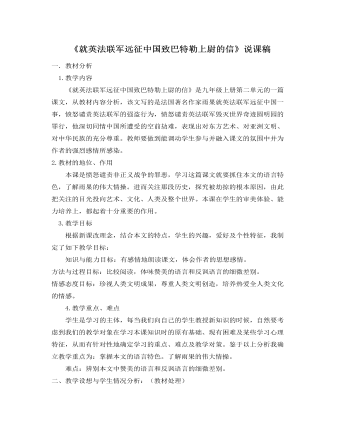
部编版语文九年级上册《就英法联军远征中国致巴特勒上尉的信》说课稿
1.教学内容《就英法联军远征中国致巴特勒上尉的信》是九年级上册第二单元的一篇课文,从教材内容分析,该文写的是法国著名作家雨果就英法联军远征中国一事,愤怒谴责英法联军的强盗行为,愤怒谴责英法联军毁灭世界奇迹圆明园的罪行,他深切同情中国所遭受的空前劫难,表现出对东方艺术、对亚洲文明、对中华民族的充分尊重。教师要做到能调动学生参与并融入课文的氛围中并为作者的强烈感情所感染。2.教材的地位、作用本课是愤怒谴责非正义战争的罪恶,学习这篇课文就要抓住本文的语言特色,了解雨果的伟大情操。进而关注那段历史,探究被劫掠的根本原因,由此把关注的目光投向艺术、文化、人类及整个世界。本课在学生的审美体验、能力培养上,都起着十分重要的作用。3.教学目标根据新课改理念,结合本文的特点,学生的兴趣,爱好及个性特征,我制定了如下教学目标:
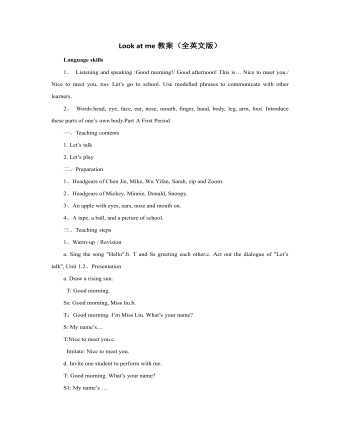
人教版新课标PEP小学英语三年级上册Look at me教案(全英文版)
3、Practicea. Nice to meet you. Nice to meet you,too.b. Perform the dialogue.c. Arrange the dialogue according to the pictures or sentence cards.d. Let’s play.A: Good afternoon,B. This is C. Hello, C! Nice to meet you.C: Nice to meet you, too.A,B: Goodbye!C: Bye!4、Assessment Workbook page 10Add-activitiesa. Listen to the recording and repeat.b. Make a dialogue according to "Let’s talk".Second Period一、Teaching contents1. Let’s learn Words:body, leg, arm, hand, finger, foot.1. Let’s do二、Preparation1、a puppet2、Cards of body, leg, arm, hand, finger and foot.3、headgear of a captain三、Teaching steps1、Warm-up/ Revisiona. Captain says to review "let’s do" of Part A.b. Perform the students their own dialogues.2、Presentationa. Learn to say "body, leg, arm, hand, finger and foot."b. Listen to the recording and repeat.c. Let’s do. Clap your hands. Snap your fingers. Wave your arms. Cross your legs. Shake your body. Stamp your foot.3、Practicea. Let’s draw a person.b. Let’s do. Point out which picture.c. Let’s do. Who responses faster.4、Assessment Workbook page 115、Add-activitiesa. Listen to the recording, repeat and act out.b. Say all the names of the body to your parents.Third Period一、Teaching contents1. Let’s check2. Let’s chant二、Preparation1、stationeries1、pictures of parts of Zoom
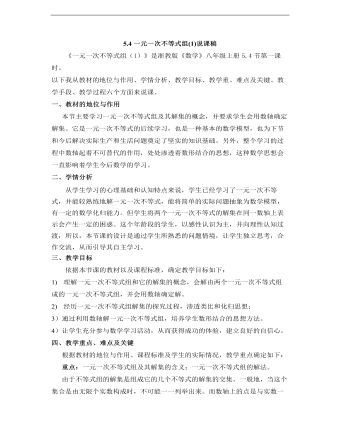
初中数学浙教版八年级上册《54一元一次不等式组(1)》说课稿
一、教材的地位与作用 本节主要学习一元一次不等式组及其解集的概念,并要求学生会用数轴确定解集。它是一元一次不等式的后续学习,也是一种基本的数学模型,也为下节和今后解决实际生产和生活问题奠定了坚实的知识基础。另外,整个学习的过程中数轴起着不可替代的作用,处处渗透着数形结合的思想,这种数学思想会一直影响着学生今后数学的学习。二、学情分析从学生学习的心理基础和认知特点来说,学生已经学习了一元一次不等式,并能较熟练地解一元一次不等式,能将简单的实际问题抽象为数学模型,有一定的数学化归能力。但学生将两个一元一次不等式的解集在同一数轴上表示会产生一定的困惑。这个年龄段的学生,以感性认识为主,并向理性认知过渡,所以,本节课的设计是通过学生所熟悉的问题情境,让学生独立思考,合作交流,从而引导其自主学习。
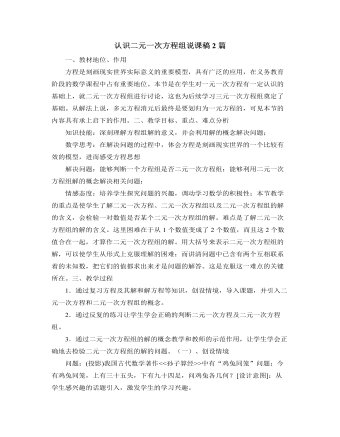
北师大版初中八年级数学上册认识二元一次方程组说课稿2篇
我们遇到的往往就是这样的方程组,我们要想比较简捷地把它解出来,就需要转化为同一个未知数系数相同或相反的情形,从而用加减消元法,达到消元的目的.请大家把解答过程写出来.解:①×3,得:6936xy??,③②×2,得:3486??yx,④③-④,得:2?y.将2?y代入①,得:3?x.根据上面几个方程组的解法,请同学们思考下面两个问题:(1)加减消元法解二元一次方程组的基本思路是什么?(2)用加减消元法解二元一次方程组的主要步骤有哪些?(由学生分组讨论、总结并请学生代表发言)[师生共析](1)用加减消元法解二元一次方程组的基本思路仍然是“消元”.(2)用加减法解二元一次方程组的一般步骤是:①变形----找出两个方程中同一个未知数系数的绝对值的最小公倍数,然分别在两个方程的两边乘以适当的数,使所找的未知数的系数相等或互为相反数.②加减消元,得到一个一元一次方程.③解一元一次方程.
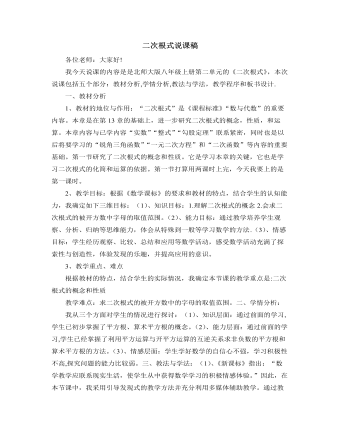
北师大版初中八年级数学上册二次根式说课稿
有意义,字母x的取值必须满足什么条件?设计意图:通过例题的讲解,使学生加深对所学知识的理解,避免一些常见错误。而变式练习设计,延续的例题的风格,一步一步,步步深入,本节课的教学难点就在学生的操作活动中迎刃而解了。对提高学生对所学知识的迁移能力和应用意识,激发好奇心和求知欲起到良好效果。(五)、巩固运用,提高认识1、通过基础训练让学生体验学习的成就感。2、应用拓展:增加难处,再次让学生联系以前的知识,增强学生的数学应用意识。(六)、总结评价,质疑问难这节课我们学习了什么?设计意图:学生共同总结,互相取长补短,学生在畅所欲言中对二次根式的认知得到进一步的巩固升华。五、板书设计.采用纲领式的板书,使学生有“话”可说,有“理”可循,在简单板书设计中使学生体会到数学的简洁美。
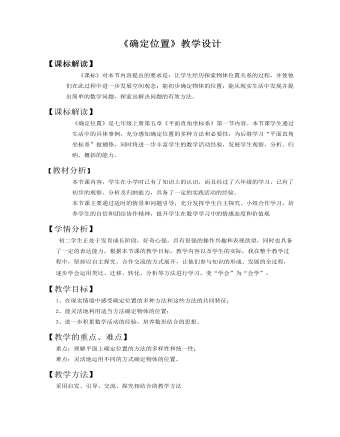
初中数学鲁教版七年级上册《第五章 位置与坐标 1 确定位置》教学设计教案
1、通过同位之间互说座位位置,检测知识目标2、3的达成效果。2、通过导学案上的探究一,检测知识目标2、3的达成效果。 3、通过探究二,检测知识目标1、3的达成效果。 4、通过课堂反馈,检测总体教学目标的达成效果。本节课遵循分层施教的原则,以适应不同学生的发展与提高,针对学生回答问题本着多鼓励、少批评的原则,具体从以下几方面进行评价:1、通过学生独立思考、参与小组交流和班级集体展示,教师课堂观察学生的表现,了解学生对知识的理解和掌握情况。教师进行适时的反应评价,同时促进学生的自评与互评。2、通过设计课堂互说座位、探究一、二及达标检测题,检测学习目标达成情况,同时有利于学生完成对自己的评价。3.通过课后作业,了解学生对本课时知识的掌握情况,同时又能检测学生分析解决问题的方法和思路,完成教学反馈评价。

人教版新课标小学数学二年级上册表内乘法(一)教案
(6)交流。6的乘法口诀一共有几句?口诀中的第一个数与算式中的第二个因数相同,表示什么?口诀中的第二个数与算式的第一个因数相同,表示什么?相邻两句口诀的积相差几?哪几句难记一些?你用什么方法记呢?怎样记住"三六十八"、"四六二十四"两句口诀?教师在学生发言的基础上鼓励学生大胆说、想出不同记口诀的方法。(7)应用"做一做"第1题(学生半独立完成):①用6根小棒摆1个六边形;②摆2个六边形要用多少根小棒?你是怎样想的?(想口诀"二六十二"。)③运用所学的口诀口答摆4个、6个、3个、5个六边形所需要向小棒数。"做一做"第2题(独立完成):①将第2题改为填空题,在圆圈内填写正确的积;②口答得数,并说一说所用口诀。
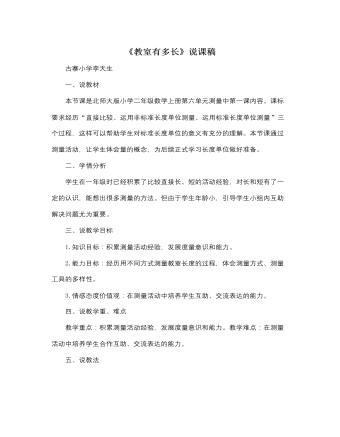
北师大版小学数学二年级上册《教室有多长》说课稿
一、说教材本节课是北师大版小学二年级数学上册第六单元测量中第一课内容。课标要求经历“直接比较、运用非标准长度单位测量、运用标准长度单位测量”三个过程,这样可以帮助学生对标准长度单位的意义有充分的理解。本节课通过测量活动,让学生体会量的概念,为后续正式学习长度单位做好准备。二、学情分析学生在一年级时已经积累了比较直接长、短的活动经验,对长和短有了一定的认识,能想出很多测量的方法。但由于学生年龄小,引导学生小组内互助解决问题尤为重要。三、说教学目标1.知识目标:积累测量活动经验,发展度量意识和能力。2.能力目标:经历用不同方式测量教室长度的过程,体会测量方式、测量工具的多样性。3.情感态度价值观:在测量活动中培养学生互助、交流表达的能力。四、说教学重、难点教学重点:积累测量活动经验,发展度量意识和能力。教学难点:在测量活动中培养学生合作互助、交流表达的能力。
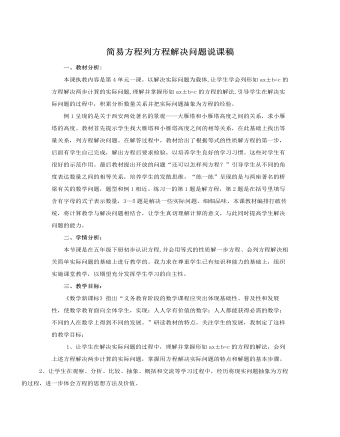
人教版新课标小学数学五年级上册简易方程列方程解决问题说课稿
设计意图:在游戏中巩固策略,提高学生学习兴趣,缓解学习疲劳。这个游戏的“揭密”过程关注方法的多样化,让学生体会列方程的策略和倒推策略之间的联系,把新旧知识进行了有机地融合,以培养学生思维的灵活性和发散性。四、课堂小结 提升策略提问学生:这节课你学会了应用什么策略解决实际问题?什么类型的题目适合用今天的策略解答?用这样的策略解决实际问题要注意什么?你还有别的收获吗?设计意图:突出主题,让学生总结本课的学习内容和学习重点;同时关注学生的个性发展,引导学生进行个性化的总结,体现不同层次的学生对课堂教学的领悟程度。五、课堂作业列方程解决实际问题,完成练习一4、5两题。设计意图:及时反馈学生学习情况,为后续教学研究收集宝贵的教学信息。
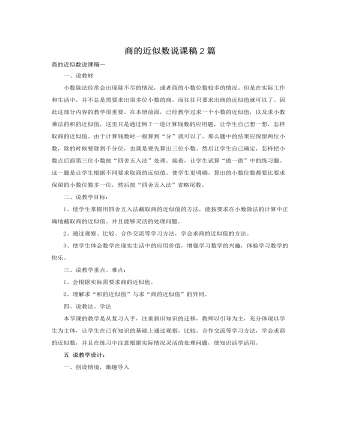
人教版新课标小学数学五年级上册商的近似数说课稿2篇
师生在共同板演竖式计算的基础上,引导学生探讨如何求商的近似值的解决方法。需保留几位小数?除的时候该怎么办?帮助学生总结出取商的近似值的一般方法;即要保留一位,要看第二位,也就要除到第二位。即要保留二位,要看第三位,也就要除到第三位。以此类推,这个方法是学生在尝试练习中自己得出的结论,是本课教学的重点所在。数学教学需要学生的感悟,感悟方法,感悟规律。然后在引导学生比较求商的近似值和求积的近似值的异同点:还可根据学生的接受情况,介绍一种简便的方法,即除到要保留的小数位数后,不再继续除了,只把余数同除数做比较,若余数比除数的一半小,就说明求出下一位商要直接舍去;若余数等于或大于除数的一半,就说明要在已除得的商的末一位上加1。通过归纳、整合知识,让学生明白如何求商的近似值。计算后,强调一些细节问题:如横式中用“约等于”连接,竖式的正确书写及答案中写上“约”字等,培养学生良好的计算和书写习惯。
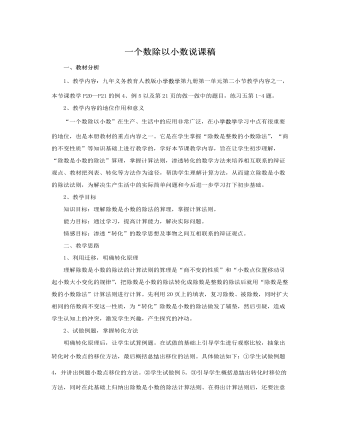
人教版新课标小学数学五年级上册一个数除以小数说课稿
(由除数的小数位决定。因为我们只要把除数转化成整数就成了除数是整数的小数除法。如:0.756÷0.18=75.6÷18。)(设计意图:在试做的基础上引导学生初步感受转化时小数点的移位方法,为自主概括法则作铺垫)2、学习例5:买0.75千克油用10.5元。每千克油的价格是多少元?学生列式:10.5÷0.75。①要把除数0.75变成整数,怎样转化?(把除数0.75扩大100倍转化成75。要使商不变,被除数也应扩大100倍。)②被除数10.5扩大100倍是多少?(10.5扩大100倍是1050,小数部分位数不够在末尾被“0”。)3、比较例4与例5有什么不同?(被除数在移动小数点时,位数不够在末尾用“0”补足。)4、练习:课本P21练一练第2题,学生独立完成后,归纳小结。(设计意图:对被除数小数点移位后补“0”的方法,教师可作适当点拨。学生试做后先不急于讲评,让他们对照教材中的两个例题启发学生观察、比较两道例题的不同点与计算时的注意点。引导学生分析、比较,逐步抽象出移位的方法。)